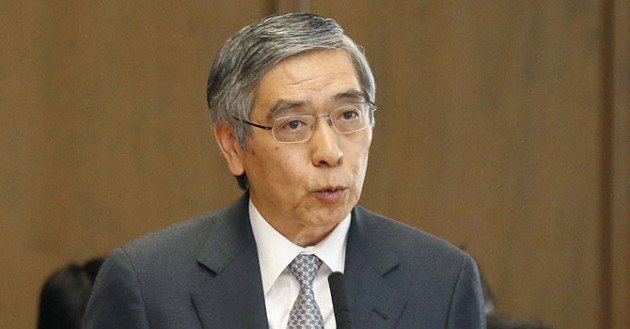Japan to slash budget


Bank of Japan Governor Haruhiko Kuroda speaks to the Press at the BOJ headquarters in Tokyo yesterday after a two-day policy meeting. – AFP
TOKYO. – Japan yesterday pledged to cut a whopping US$83 billion out of its budget over two years as it works to bring down the industrialised world’s biggest debt mountain. The move – amounting to an average reduction of more than 4 percent of current annual spending – comes days after the International Monetary Fund warned again over Tokyo’s borrowings.
The budget pledge was outlined in the government’s mid-term fiscal plan, which called for US$83 billion to be lopped off Tokyo’s deficit between April 2014 and March 2016. There were few details about where the reductions would be made.
The projections come as Prime Minister Shinzo Abe’s administration works to boost the world’s third-largest economy after years of tepid growth.
Japan’s annual budget is about 93 trillion yen, with some 40 percent of that spending coming from borrowing which has created a debt pile that is more than twice as big as the nation’s economy – the worst among industrialised nations.
The country has not faced a public debt crisis like the kind seen across the eurozone, however, largely because most of its low interest rate debt is held domestically rather than by international creditors. But the IMF and others have warned over Tokyo’s ever-increasing debt levels, saying it must follow through on key fiscal and structural reforms to the economy.
Abe’s hand-picked governor at the Bank of Japan also joined the chorus of voices over the debt problem yesterday, saying the central bank’s huge stimulus drive could “diminish without fiscal reforms”.
“It is extremely important for the government to clarify the path of fiscal rehabilitation and to move ahead with fiscal and structural reforms,” BoJ chief Haruhiko Kuroda said after the bank wrapped up a two-day policy meeting, leaving its monetary easing scheme unchanged.
A key part of the premier’s economic policy, dubbed “Abenomics”, has been big government spending and a huge monetary easing plan unveiled by the central bank in April, as Tokyo looks to conquer years of growth-sapping deflation.
But balancing the books while shaking up Japan’s protected economy, a key plank of Abe’s plan, is a difficult sell to many of the country’s cosseted industries.
On Monday, the IMF called on Tokyo to adopt a “credible” strategy that includes raising sales taxes to boost government revenue and deregulating the farming sector among others. Tokyo’s latest spending plan is based on what some analysts say is an optimistic scenario in which the economy would grow an average of two percent annually over the next decade, while cutting back on new borrowing.
Hideo Kumano, senior economist at Dai-ichi Life Research Institute in Tokyo, said sustained growth could help Tokyo handle deep budget cuts.
“But the contribution would be limited,” he said.
“Also, the government’s plan is based on a very optimistic forecast of economic growth.”
Abe’s government is mulling whether to go ahead with a series of sales tax hikes that would double the rate to 10 percent by 2015, a key new revenue driver but one that some fear would stall Tokyo’s economy-boosting plan. In a report yesterday, credit rating agency Moody’s warned that Abenomics may backfire unless it stimulates real growth in an economy that has struggled for two decades. – AFP.










Comments